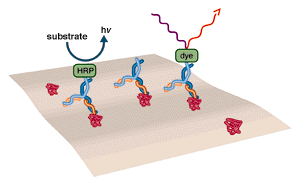Mechanism of Immunostaining
The basic method of immunostaining is to probe with an antibody that is bound to a detectable molecule such as an enzyme or a fluorescent dye. The highly specific binding interaction between antibodies and their unique antigens has been exploited to create sensitive and specific detection systems for proteins. An antibody can be raised and/or…
Read MoreDNase I Footprinting
A method for determining the location of a protein binding site, DNase I Footprinting Analysis involves endonuclease treatment of an end labeled DNA fragment bound to a protein. Limited digestion yields fragments terminating everywhere except in the footprint region, which is protected from digestion. DNase I Footprinting Procedure Preparing the DNA substrate: DNA to be…
Read MoreLiquid Scintillation and Radiation Safety
Working with radioactive isotopes requires diligent attention to safety measures, in order to avoid hazardous exposure(s). Because radioactivity cannot be detected without instrumentation, spills can easily be spread through and even out of the lab before they are noticed. Safety in radioisotope work requires sufficient attention to both containment and surveillance. Containment measures are designed…
Read MoreHPLC Flow Counting
Radiolabeled materials are often analyzed by chromatography. The original application of liquid scintillation counting to chromatographic techniques was to collect and count discrete fractions. This manner of counting is extremely laborious, and resolution is limited by the size of the fractions collected. Flow detectors were introduced to allow continuous LSC monitoring of column effluents. This…
Read MorePreparing Samples in PAGE Gels for LSC
Complex radioactive samples are often fractionated on polyacrylamide gels. Analysis of radiolabeled samples in electrophoretic gels follow the same pattern as that on TLC plates. The gel is analyzed as a whole for radioactive bands, which are then excised and counted to obtain quantitative results. National Diagnostics’ Autofluor can be used to enhance the autoradiography…
Read MorePreparing Tissue Samples for Scintillation Counting
Samples of animal or plant tissue are rarely thin or small enough to allow for full counting efficiency. Homogenization of such samples will allow them to be dispersed into a cocktail, but processing large numbers of radioactive samples by homogenization is not practical. To allow for efficient and consistent counting of tissue samples, tissue solubilizers…
Read MoreCounting Samples on Cellulose-Ester Filters
A common radiotracer technique is to precipitate macromolecules (protein & DNA) with TCA or some other strong denaturant, collect the precipitate on a filter and count it. Often such procedures give variable results, depending upon the degree to which the sample disperses from the filter into the cocktail. A typical artifact is counts which rise…
Read MoreCounting Samples from TLC Plates by LSC
In a typical TLC experiment, the radioactivity is detected at two points: after TLC it is analyzed by autoradiography, to locate radioactive spots. These spots are then scraped off of the plate and counted to provide quantitative information. Each of these steps can be enhanced using the following protocols. Autoradiography and LSC with TLC Plates…
Read MoreWaste Disposal Issues in Scintillation Counting
An aspect of LSC which must be considered in experimental design, is waste disposal. Unlike solid scintillation, LSC adds components to the sample increasing the volume of radioactive material by up to 1000 fold. The components of the LSC cocktail may represent a hazard or a disposal problem in addition to the radioactivity. For many…
Read MoreChemiluminescence and Static Electricity
Another commonly encountered artifact is chemiluminescence. This is caused by any chemical reaction which generates an excited product molecule, which decays to emit light. These reactions generate only a single photon, which may be quenched, or may reach the counter to register as a low energy emission event. Such reactions can generate 105-106 cpm, skewing…
Read More
